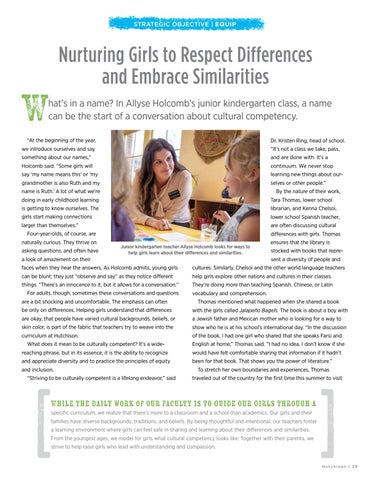STRATEGIC OBJECTIVE | EQUIP
Nurturing Girls to Respect Differences and Embrace Similarities
W
hat’s in a name? In Allyse Holcomb’s junior kindergarten class, a name can be the start of a conversation about cultural competency.
“At the beginning of the year,
Dr. Kristen Ring, head of school.
we introduce ourselves and say
“It’s not a class we take, pass,
something about our names,”
and are done with. It’s a
Holcomb said. “Some girls will
continuum. We never stop
say ‘my name means this’ or ‘my
learning new things about our-
grandmother is also Ruth and my
selves or other people.”
name is Ruth.’ A lot of what we’re
By the nature of their work,
doing in early childhood learning
Tara Thomas, lower school
is getting to know ourselves. The
librarian, and Kenna Chelsoi,
girls start making connections
lower school Spanish teacher,
larger than themselves.”
are often discussing cultural
Four-year-olds, of course, are naturally curious. They thrive on asking questions, and often have
differences with girls. Thomas Junior kindergarten teacher Allyse Holcomb looks for ways to help girls learn about their differences and similarities.
a look of amazement on their
ensures that the library is stocked with books that represent a diversity of people and
faces when they hear the answers. As Holcomb admits, young girls
cultures. Similarly, Chelsoi and the other world language teachers
can be blunt; they just “observe and say” as they notice different
help girls explore other nations and cultures in their classes.
things. “There’s an innocence to it, but it allows for a conversation.”
They’re doing more than teaching Spanish, Chinese, or Latin
For adults, though, sometimes these conversations and questions are a bit shocking and uncomfortable. The emphasis can often
vocabulary and comprehension. Thomas mentioned what happened when she shared a book
be only on differences. Helping girls understand that differences
with the girls called Jalapeño Bagels. The book is about a boy with
are okay, that people have varied cultural backgrounds, beliefs, or
a Jewish father and Mexican mother who is looking for a way to
skin color, is part of the fabric that teachers try to weave into the
show who he is at his school’s international day. “In the discussion
curriculum at Hutchison.
of the book, I had one girl who shared that she speaks Farsi and
What does it mean to be culturally competent? It’s a wide-
English at home,” Thomas said. “I had no idea. I don’t know if she
reaching phrase, but in its essence, it is the ability to recognize
would have felt comfortable sharing that information if it hadn’t
and appreciate diversity and to practice the principles of equity
been for that book. That shows you the power of literature.”
and inclusion. “Striving to be culturally competent is a lifelong endeavor,” said
To stretch her own boundaries and experiences, Thomas traveled out of the country for the first time this summer to visit
While the daily work of our faculty is to guide our girls through a specific curriculum, we realize that there’s more to a classroom and a school than academics. Our girls and their families have diverse backgrounds, traditions, and beliefs. By being thoughtful and intentional, our teachers foster a learning environment where girls can feel safe in sharing and learning about their differences and similarities. From the youngest ages, we model for girls what cultural competency looks like. Together with their parents, we strive to help raise girls who lead with understanding and compassion.
Hutchison | 29




